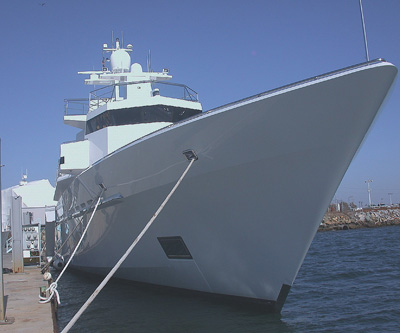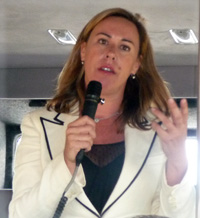
By Donald H. Harrison

NATIONAL CITY, California—In the mid 1980s, San Diego’s Acting Mayor Bill Cleator organized the San Diego Cruise Industry Consortium – an association of private and public entities that all shared an interest in attracting cruise ships to this city. Thirty years later, thanks to a sustained marketing follow-up by the Port of San Diego, there are several hundred cruise ship calls in San Diego annually adding both glamour and economic vitality to the city’s waterfront.
In this decade, a successful effort also has been underway to attract another class of shipping to San Diego Bay—the so-called super yachts, 120 feet long or more, of which there are approximately 7,000 in the world. Among the companies leading the local drive is the Knight & Carver Yacht Center, which has refitted a dozen of the luxury vessels and now is preparing to bring a 400-foot-long drydock to San Diego so it can attract even more.
This burgeoning San Diego super-yacht industry has involved some members of the Jewish community, both as customers and vendors. One such customer is Larry Ellison, who as the founder of the Oracle software companies, is ranked as one of the world’s richest men. Ellison sent the 192-foot yacht Ronin to San Diego in 2005 for a job worth several million dollars to the local economy. At its facility at the National City Marine Terminal, Knight & Carver performed “various engineering jobs, full paint job, interior refresh and a lot of varnish work,” recalls Kate Pearson, the company’s vice president for business development. Furthermore, one of the founders of the firm, Meri Knight, as well as its current board chairman, Sampson Brown, are Jewish community members.
With 125 employees, Knight & Carver has won considerable attention in the super-yacht industry, to the point that in 2007 it was named “Boatyard of the Year” by American Boat Builders & Repairers Association.
Berthing a super yacht for a major refit can pay big dividends, said Pearson during a briefing for the news media last week. “The project on Helios (a super yacht) was $25 million accomplished right here at the dock with the collaboration of lots of subcontractors, including one from Sweden that has now moved into Southern California to cultivate our market.”

Pearson said that “the reason we like these yachts is not only for their glamour, which they have, but what they do for our economy. The 200-foot yachts generally travel with 30 crew. When they are coming into the yard, the primary economic impact is the labor and material that we sell to these boats, but the secondary impact is the money that the crew spends in the local economy. The tertiary impact is the stimulus to other businesses –restaurants and hotels—so we see them (super yachts) as being an economic agent.”
Along with competitor boatyards, Knight & Carver has been marketing San Diego to yacht owners around the world through a 32-member organization named the San Diego Super Yacht Association.
“Our job is to promote San Diego in the global market place,” Pearson said. Year-round good weather is one reason why San Diego is an ideal temporary port, she said. There is no hurricane season in San Diego as there is in Fort Lauderdale, which is considered the super-yacht capital. Additionally, Pearson said, the Pacific Ocean ports to which one can sail from San Diego offer an exciting change of pace to yacht-owners used to the Caribbean.
As the yachts can travel in style to almost any port with a boatyard, the competition for their business is global in scope. San Diego not only needs to worry about Fort Lauderdale, but also about resort ports in Europe, Asia, New Zealand and Pearson’s own native Australia.
Obtaining a floating drydock capable of lifting very long yachts out of the water has been a priority for Knight & Carver, which expects to bring the 400-foot long, 96-foot wide drydock “Diligence” to National City this summer. Having the facility in San Diego will allow the company to compete for top echelon super yachts. “This will allow us to grow and we will be partnering with a lot of smaller subcontractors who rely on this drydock,” Pearson said.
Super-yacht business is but one aspect of San Diego’s “working waterfront,” as its industrial and maritime sector is called. “There are a total of about 600 businesses on San Diego Bay,” said Jim Hutzelman, the Port’s assistant director for community services. These are divided into two genres: industrial businesses including manufacturing and boat yards, and visitor services, including hotels, marinas, tour boats and the like.
“The total impact of businesses on the port of San Diego tidelands is about $10.6 billion,” Hutzelman said. “Of that $7.6 million actually comes from the maritime trade and industrial businesses.”
The United States Navy operates numerous facilities on San Diego Bay, bringing many billions of dollars to the local economy. Those operations handled exclusively by the military are not computed in the Port’s total. However, in some cases—under the nation’s ‘Strategic Ports’ program—the military spends money on civilian port facilities and services.
“The military looked at the West Coast several years ago and found that the West Coast was very congested and they did not have reserve capacity to move military equipment off the West Coast quickly,” explained Dirk Mathiasen, the Port’s vice president for operations.
“So they began putting together a system of ports for military moves that they call ‘strategic ports’ and San Diego is one of those ports on the West Coast. By being designated as that, we agree to provide them a certain amount of capacity on certain amount of notice from the military. ”
Other departments within the federal government are modifying their patterns of interaction with West Coast ports, Mathiasen said.
Several months ago, U.S. Transportation Secretary Ray La Hood “began a series of outreach meetings, and there was one here in San Diego, with all the port directors from around the country” to discuss possible implementation of a holistic approach to transportation, Mathaisen said.
“For instance, if you have something in Los Angeles and you want to move it to San Diego, is it better to clog the freeways or to bring that down to San Diego on a barge or a boat?” Mathiasen asked rhetorically.
Mathiasen said San Diego’s industrial waterfront essentially stretches from the 10th Avenue Marine Terminal on the north to the National City Marine Terminal on the south, with such businesses in between as Kelco (which processes kelp) and four major shipyards.
On the Tenth Avenue Marine Terminal, he said, the Port handles such bulk commodities as cement and sand, which are used in local construction projects, and also has a fuel farm which handles jet fuel for the international airport at Lindbergh Field as well as marine fuel for the cruise ships, yachts and other vessels in San Diego Bay.
The National City Marine Terminal is the port’s main staging area for automobiles being shipped in and out of the country. The automobiles are moved from ships to car carriers and to trains, and vice versa.
*
Harrison is editor of San Diego Jewish World